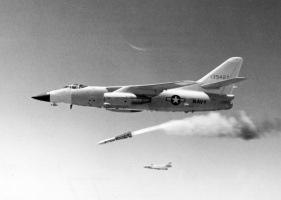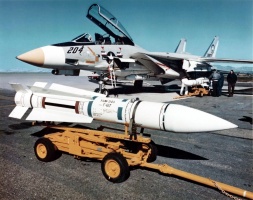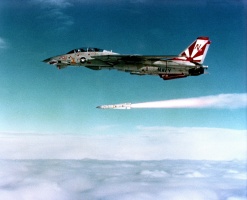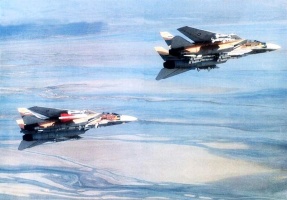AIM-54A Phoenix
Contents
Description
The AIM-54A Phoenix is an American active radar homing missile. It was introduced in Update "Danger Zone". The AIM-54A Phoenix is the first active-radar homing missile introduced in War Thunder.
Vehicles equipped with this weapon
General info
| Missile characteristics | |
|---|---|
| Mass | 443.61 kg |
| Guidance | ARH+IOG+DL |
| Signal | CW |
| Lock range | 16 km |
| Launch range | 150 km |
| Maximum speed | 4.3 M |
| Maximum overload | 17 G |
| Missile guidance time | 160 secs |
| Explosive mass | 60.54 kg TNTeq |
The Phoenix is a missile specialized for long-range engagements and therefore has a very long range. However, it has a slow acceleration and a 17G manoeuvring limit, impeding its manoeuvrability.
Effective damage
The AIM-54 is equipped with a 60 kg TNT warhead, capable of destroying targets with wide proximity fuse.
Comparison with analogues
The Phoenix has a very long range, much longer than the AIM-7F Sparrow. Due to the slow acceleration and 17G manoeuvring limit, the AIM-7F Sparrow and R-24s thoroughly outclass the Phoenix when the target is under 20 km range.
Compared to the AIM-7E-2 and Skyflash, the Phoenix has a much, much longer range, but the Sparrow retains the manoeuvrability advantage.
When compared to other radar-guided missiles in the game, the Phoenix stands alone as a dedicated long-range weapon, and excels at the job that no other missile can do. While only able to pull 17G, the missile remains a menace for targets even 60 km away from the launching aircraft.
Usage in battles
Air RB:
The AIM-54 is best used in long-range engagements at high altitudes. This comes from its low acceleration and very long burn time when compared to missiles like the AIM-7 or R-27 series. Generally speaking, the higher and faster the launch aircraft is going, the higher the probability of kill of the missile. In Air RB, it is recommended to take 0, 1, or 2 Phoenixes, depending on your playstyle. 3 or more is not recommended due to taking up spots for other, more useful missiles and weighing down the already-heavy F-14 Tomcat.
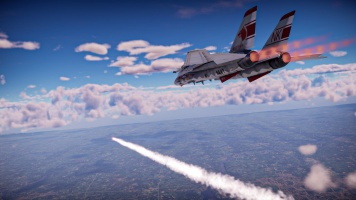
As the AIM-54 is an active-radar-homing missile, the launching aircraft is not required to Single Target Track (STT), more commonly known as a "hard lock," the target of the missile. Instead, it is recommended to select a target using manual radar target selection in the Track-While-Scan (TWS) mode of the Tomcat's radar. Once a target is selected in TWS, the missile may be cued and launched at distances sometimes exceeding 40 km on top tier maps. TWS also allows for missiles to be launched at multiple enemies, by selecting a different target in TWS. TWS will provide updates to launched missiles as long as the target they were launched on is being picked up by the radar.
It is recommended to climb to at least 5 km altitude, with 8, 9, or even 10-11 km not being out of the question depending on the map, and accelerate to at least Mach 0.9 before launching a Phoenix, which allows the missile to already have 1/4 of its maximum speed and fly in thinner air, therefore going farther and faster.
While the maximum range of the AIM-54 is advertised as 100 miles, the practical range is far shorter, as the described range can only be achieved with both targets flying high-Mach towards each other at closing speeds exceeding Mach 4. In War Thunder, in a situation where two aircraft are flying head-on at normal combat speeds, the best launch distances are 20-50 km, with 60 km or even 70 km shots being barely possible in exceedingly rare circumstances. Below 20 km, you are better off using the AIM-7F, as the benefits of the AIM-54 are practically eliminated once the range is that short.
Pros and cons
Pros:
- Has an active radar homing (ARH) seeker, which gives it fire-and-forget capability
- Can reach ranges that no other weapon system in the game can reach; if high enough in altitude can hit targets beyond 50 km
- Extremely fast at high altitudes after ramp-up acceleration
- Can be launched in TWS, which gives the target no radar lock notification until the missile goes pitbull
- Large proximity fuse and warhead means it can still deal significant damage if it is somewhat close to the enemy (e.g. upon a near miss)
Cons:
- Can only pull 17 Gs, making it easily dodgeable
- Accelerates slowly, taking a lot of time to reach top speed
- Heavy and large; equipping it impacts flight performance
- Fire and forget capability means you cannot stop it if it accidentally locks on to a friendly aircraft
- May lose track right after the launch if TWS lock is lost
History
Development
Development of an American long-range air-to-air missile trace back to 1958, when Hughes was awarded a contract by the United States Air Force for the GAR-9 missile (designated in 1962 as the AIM-47). The GAR-9 which was to have a range of 160 km (100 mi) and a 45 kg (100 lb) warhead. Due to the long distances required, the missile was given an active radar seeker in order to attack their target. The US Navy, seeking a fleet-defense weapon since the late 1950s, took interest in the GAR-9 design as a potential candidate and contracted Hughes in 1962 to develop a new long-range air-to-air missile, designated AAM-N-11, for their fleet interceptor. AAM-N-11 would be later designated in June 1963 as the AIM-54A Phoenix.[1]
Compared to the preceding AIM-47, Hughes' AIM-54 featured an AN/DSQ-26 semi-active radar homing seeker for cruising while receiving updates on the target position. The missile switches over to active radar homing for the terminal attack around 18 km (~11 mi) from the interception point. The AIM-54 featured a Rocketdyne Mk47 or Aerojet Mk60 rocket motor that helped propelled the missile more than Mach 4. The missile maintain the range specification of 160 km and was to be able to attack both aircraft and cruise missiles. The warhead is a 60 kg (132 lb) MK 82 blast-fragmentation warhead that was trigger by a fuse system consisting of radar proximity, IR proximity, and an impact fuse.[2]
Flight tests of the prototype (XAIM-54A) started in 1965, with the first interception tests taking place on 08 September 1966 at the Navy Pacific Missile Range, fired from a Douglas A-3A Skywarrior.[3] The aircraft platform for the AIM-54 Phoenix was originally the F-111B, an aircraft intended to have commonality with the US Air Force's F-111 Aardvark, but the F-111B was cancelled in 1968. The US Navy set to work building a new fleet-defense fighter to their specifications on 03 February 1969, which produced the F-14A Tomcat. The F-14A can carry six AIM-54 missiles linked with its AN/AWG-9 radar, allowing the aircraft to fire all six AIM-54 missiles simultaneously at separate targets.[1]
Hughes received a production contract for the AIM-54 missile in December 1970 as more tests with the missiles continue to show its capabilities. During November 1973, the missile passes its technical evaluation and is slated to be ready for deployment with the F-14A. The F-14A's capability with the AIM-54 was shown during an exercise on 21 November 1973, where a F-14A fired six AIM-54 missiles within 38 seconds towards six different targets up to 50 miles (~80.5 km) away, with four missiles hitting their targets. The missile was officially adopted into the US Navy service the same year and ready to be operationally deployed with the F-14A in November 1974. At the time, the missile costed $477,131 USD, which is roughly $3 million USD in 2022 adjusted for inflation.[3]
Other variants of the AIM-54A developed, primarily for training purposes, were the ATM-54A with an inert warhead for firing exercises, the CATM-54A as a non-launching missile for target acquisition practice, the DATM-54A for ground-handling training, and the AEM-54A that contained telemetry electronics for test and evaluation purposes.[2]
The AIM-54A would continue production until 18 November 1980 with a total of 2,505 units as it was replaced by the improved AIM-54C Phoenix missile.[3]
Iranian service
The AIM-54A Phoenix would never be used in combat in F-14As piloted by American crew. Instead, most of the AIM-54A aerial victories were scored by the nation Iran.
Iran, under the Shah, made a signed contract in January 1974 for 30 F-14A Tomcats and includes 424 AIM-54As, with another 50 F-14As and 290 AIM-54A missiles in June the same year. However, only 274 Phoenixes and 10 training missiles would be delivered prior to the Iranian Revolution.[4]
The new Islamic Republic of Iran Air Force (IRIAF) would use the procured F-14A and AIM-54A Phoenix missiles in the Iran-Iraq War that launched in 1980. The first air victory credited to the AIM-54A Phoenix occurred on 13 September 1980 when a patrolling Iranian F-14A of 81st Tactical Fighter Squadron (TFS) from Tactical Fighter Base 8 (TFB 8) shot down a MIG-23MS.[5] On 07 January 1981, two Iranian F-14A from TFB 8 spotted four MiG-23BN flying in a tight formation and launched a AIM-54A from a distance of 50 km. The missile detonated on the lead MiG, but the explosion, debris, and tight formation the MiGs were flying in led to two other MiG-23s crashing. This is currently the only known case of a single anti-aircraft missile downing three aircraft.[6]
The IRIAF continued to use the AIM-54A Phoenixes throughout the Iran-Iraq War, even as the stocks of Phoenix missiles began to ran dry due to usage and inability to maintain AIM-54s due to the exigency of war and the lack of spare parts such as thermal batteries. The Iranians received spare parts and service-life extension kits known as Phase 1M54ALE for the AIM-54 Phoenixes as part of the Iran-Contra affair, but the stocks of AIM-54 fell below 50 working missiles by November 1987.[7] By the time a ceasefire is held on 07 July 1988 to begin ending the Iran-Iraq War, the IRIAF was credited with 62 victories with the use of AIM-54 Phoenixes.[8]
With the US retirement of the AIM-54 on 30 September 2004, the IRIAF remains the only user of the AIM-54 Phoenix missiles.[2] In an attempt to supplement their dwindling quantity of AIM-54, Iran developed a domestic production version of the missile, the Fakour-90, which was unveiled in 2013. The Fakour-90 is suspected to be derived from reverse-engineering the US MIM-23 Hawk surface-to-air missile.[9]
Media
Excellent additions to the article would be video guides, screenshots from the game, and photos.
See also
Links to the articles on the War Thunder Wiki that you think will be useful for the reader, for example:
- reference to the article about the variant of the weapon;
- references to approximate analogues by other nations and research trees.
External links
References
- Citations
- Bibliography
- Cencioti, David. 2013. "Iranian F-14 Tomcat’s “new” indigenous air-to-air missile is actually an (improved?) AIM-54 Phoenix replica." Last modified September 26, 2013. Website (Archive).
- Cooper, Tom and Farzad Bishop. 2004. Iranian F-14 Tomcat Units In Combat. Great Britain: Osprey Publishing. Kindle.
- Goebel, Greg. 2021. "[1.0] Falcon & Sidewinder." Air Vectors. Last modified July 01, 2021. Website (Archive).
- Naval Air Systems Command. 2017. "AIM-54 Phoenix Missile." United States Navy. Last modified March 10, 2017. Website (Archive).
- Parsch, Andreas. 2004. "AIM-54." Directory of U.S. Military Rockets and Missiles. Last modified October 08, 2004. Website (Archive)
- Stillion, John. 2015. Trends in Air-to-Air Combat: Implications for Future Air Superiority. Washington, DC: Center for Strategic and Budgetary Assessments. CSBA Online.


